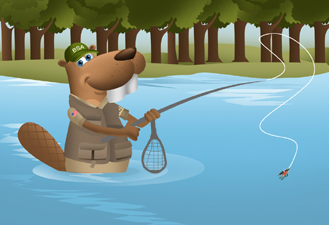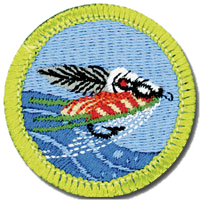Fly Fishing


Resources
- Fly Fishing Merit Badge Pamphlet
- Fly Fishing Merit Badge Class Preparation Page
- Fly Fishing Merit Badge Workbook
- Scoutmaster Bucky's Merit Badge Advancement Quick Reference
- Scoutmaster Bucky's Acknowledgement Form
Related
Fly Fishing Requirements
Current Scouts BSA requirements
as of December 6, 2025
as of December 6, 2025
1.
Do the following:
a.
Explain to your counselor the most likely hazards you may encounter
while participating in fly-fishing activities and what you should do to
anticipate, help prevent, mitigate, and respond to these hazards. Name
and explain five safety practices you should always follow while
fly-fishing.
b.
Discuss the prevention of and treatment for the following health
concerns that could occur while fly-fishing: cuts and scratches, puncture
wounds, insect bites, hypothermia, dehydration, heat exhaustion,
heatstroke, sunburn.
c.
Explain how to remove a hook that has lodged in your arm.
2.
Demonstrate how to match a fly rod, line, and leader to achieve a balanced
system. Discuss several types of fly lines, and explain how and when each
would be used. Review with your counselor how to care for this equipment.
3.
Demonstrate how to tie proper knots to prepare a fly rod for fishing:
a.
Tie backing to the arbor of a fly reel spool using an arbor knot.
b.
Tie backing to the fly line using a nail (tube) knot.
c.
Attach a leader to the fly line using a nail (tube) knot or a
loop-to-loop connection.
d.
Add a tippet to a leader using a surgeon's knot or a loop-to-loop
connection.
e.
Tie a fly onto the terminal end of the leader using an improved clinch
knot.
4.
Explain how and when each of the following types of flies is used: dry
flies, wet flies, nymphs, streamers, bass bugs, poppers, and saltwater
flies. Tell what each one imitates. Tie at least two types of the flies
mentioned in this requirement.
5.
Demonstrate the ability to cast a fly 30 feet consistently and accurately
using both overhead and roll cast techniques.
6.
Go to a suitable fishing location and observe what fish may be eating both
above and beneath the water's surface. Explain the importance of matching
the hatch.
7.
Do the following:
a.
Explain the importance of practicing Leave No Trace Seven Principles
and the Outdoor Code. Discuss the positive effects of the Leave No
Trace Seven Principles and the Outdoor Code on fly-fishing resources.
b.
Discuss the meaning and importance of catch and release. Describe how
to properly release a fish safely to the water.
8.
Obtain and review a copy of the regulations affecting game fishing where
you live or where you plan to fish. Explain why they were adopted and what
is accomplished by following them.
9.
Explain what good outdoor sportsmanlike behavior is and how it relates to
anglers. Tell how the Leave No Trace Seven Principles and the Outdoor Code
relate to a fishing sports enthusiast, including the aspects of littering,
trespassing, courteous behavior, and obeying fishing regulations.
10.
Catch one fish and identify it.
11.
If regulations and health concerns permit, clean and cook a fish you have
caught. If you are unable to catch a fish for eating, acquire a fish, clean
the fish you acquired, and cook the fish you acquired.
Note: It is not required that you eat the fish.